One weekend in nature across Canada
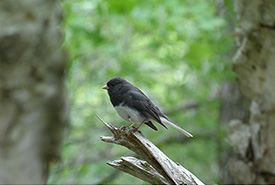
Dark-eyed junco at Shaw Wilderness Park (Photo by Katie Diespecker)
Every summer, the Nature Conservancy of Canada (NCC) hires student interns to work in a variety of areas across the organization. This year’s communications interns, Asha Swann and Katie Diepspecker, lived in different parts of the country: Asha was in Ottawa and Katie was in Halifax.
Asha’s internship focused on communications and Katie’s on assisting with managing NCC’s library of photos, videos and other digital assets. On one weekend in July, Asha and Katie each visited an NCC conservation site near them to compare wildlife and plant species. How does Gillies Grove in the Ottawa Valley differ from the Shaw Wilderness Park in Nova Scotia? In this blog post, the two interns discuss the similarities and differences between the two NCC properties.
Wildlife
Asha: Wildlife in Gillies Grove is plentiful. Birds can be heard along the trails. Hawks, owls and flying squirrels exist on this property, though they aren’t always easy to spot. Owls and woodpeckers were the first species I noticed here. Also here are scarlet tanagers; these small, bright red birds stand out in the dark green needles of the property’s eastern white pine trees. Barred owls are large and stocky birds that are harder to spot but have calls that are easy to hear. Pileated woodpeckers are drawn to forests with huge trees and dead standing trees so it’s easy to see why so many call the Gillies Grove habitat home. The abundance of large trees also attract birds of prey, such as red-shouldered hawks, which typically build nests in deciduous forests, though most of the trees in Gillies Grove are coniferous. On a clear evening, you may be lucky enough to see flying squirrels leaping across the high treetops. For the keen observer, pay attention to the forest floor: red-backed salamanders are also known to amble across the dirt paths. No matter where I was in Gillies Grove, I could hear the sounds of woodpeckers pecking against tree trunks, and common eastern grey squirrels running along the dirt paths.
Katie: As I ventured into Shaw Wilderness Park, I found it humming with wildlife. The park provides 153 hectares (380 acres) of mature forest to the various insects, birds, squirrels, turtles and other animals that live here. Shaw Wilderness Park is also home to more than 40 species of nesting birds. Songbirds like robins, golden-crowned kinglet and common yellowthroat can be heard throughout the park. While walking the trail that winds above part of William’s Lake, I sometimes heard the call of a nearby loon. If you keep an eye out, you may also see a downy woodpecker or osprey.
Geography, plants and animals
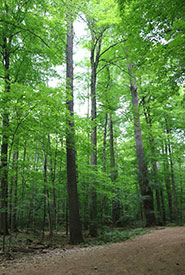
Gillies Grove trees (Photo by Asha Swann/NCC intern)
Asha: Gillies Grove is an old-growth forest. This describes a forest that has gone a century or more without major disturbances, like clearcutting or wildfires. Because the forest here has been designated as an NCC property, the plant life in Gillies Grove has been able to flourish. Trees in the grove are everywhere, providing continuous shade. The trees are so lush and plentiful that it’s easy to forget you’re near the centre of the town of Arnprior. Eastern white pines are plentiful, but that’s not the only type of plant. Sugar maples, American beech, hepatica flowers, ghost pipes, violets, red and white trilliums (and the occasional poison ivy) are everywhere. As with any older forest, there are dead trees and hollowed-out trunks on the ground. Dead trees provide habitat for insects, birds, fungi and other wildlife essential for the ecosystem’s balance. As of 2015, the highest tree in Ontario also stands in Gillies Grove. Reaching approximately 47 metres in height, the eastern white pine tree is an amazing sight to behold. Seeing these trees was a great reminder of how many species live in and depend on these types of forests.
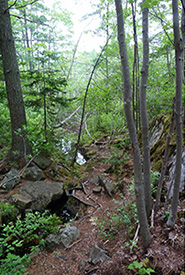
Shaw Wilderness Park trees (Photo by Katie Diespecker/NCC intern)
Katie: While not a designated old-growth forest, the forest at Shaw Wilderness Park is a beautiful, lush area. Clusters of young trees, along with more mature ones grow densely enough that I often couldn’t see far. Deeper into the park, the hum of nearby traffic faded into the sound of the wind and it was easy to forget that I was still in the city. Twisting roots break up the trail, sometimes creating convenient footholds and sometimes obstacles.
The trail soon begins to gain elevation and eventually emerges into a more open area. Here, smooth, exposed bedrock is surrounded by rugged-looking jack pine. On the ground, I noticed patches of wild blueberries and various lichens. From this vantage point, I could also see a spectacular view of the surrounding forest and the city in the distance.
Walking trails
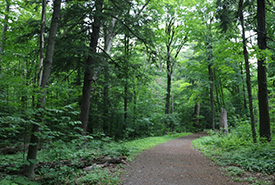
Gillies Grove trail (Photo by Asha Swann/NCC intern)
Asha: Several walking trails criss-cross Gillies Grove. Signs to stay on the path are conveniently located throughout. When walking in any forest, always stay on the path. The signs are placed for your own safety. Straying from the path can mean potentially coming into contact with poison ivy. Remember, never touch any plant you are unfamiliar with, especially if you aren’t familiar with the leaf pattern of poison ivy/poison oak. All of the paths that I walked through on my trip here were quite wide, easy for my family to walk through while still keeping our distance from other families with strollers going in the opposite direction. The flat trails are free of major tripping hazards. Though small branches do sometimes cross the path, they were easy to spot and avoid. The 3.6-kilometre circular trail provides a beautiful experience of the forest.
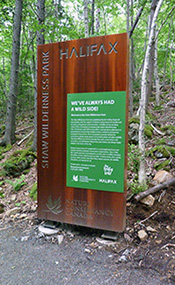
Shaw Wilderness Park sign (Photo by Katie Diespecker/NCC intern)
Katie: The path leading from the entrance of Shaw Wilderness Park is much like those at Gillies Grove. It is a wide, flat gravel path that quickly leads up to the bank of William’s Lake. From here, a left turn brings you to the start of this park’s real adventure. The path abruptly becomes a much rougher, narrower and less manicured trail; a true backcountry experience. Rocks, stray branches and roots are common obstacles, and the route leading up to the barrens gains significant elevation. Trees are marked with reflective markers or brightly coloured tape to indicate where the trail heads. At the top of the climb, I was greeted with jack pine and broom-crowberry barrens, which are unique to Nova Scotia, as well as beautiful views of the park and surrounding city. On the way down, I encountered three other people making the trek up the trail. The paths are narrow, but there was still enough space to pass one another.
Nearby bodies of water
Asha: Gillies Grove is near the Madawaska and Ottawa rivers. These two bodies of water are vulnerable to pollution and sewage, a problem that is so serious in Ottawa that the city has constructed a $232-million tunnel to try and divert pollutants away from the water. American eel is just one of many species listed as threatened that depend on the Ottawa River. I didn’t see any aquatic species while on my walk through Gillies Grove, but I could hear the sounds of rushing water as I was walked along the trail.
Katie: William's Lake is a man-made lake that was created by settlers in the 1700s to collect rainwater. Homes and backyards can be seen dotting the shoreline. In 2020, the 153-hectare (380-acre) Shaw Wilderness Park was established by the Nature Conservancy of Canada, The Shaw Group and the Halifax Regional Municipality. This property conserves part of the shoreline of both William’s Lake and Colpitt Lake.
Following the more rugged trail deeper into the park eventually leads to Colpitt Lake. Contrasted with the previous lake, the shore of Colpitt Lake is untouched by housing. The trail around this lake lead me to many picturesque spots. The dense green trees around the edge of the water are a beautiful view.
A welcome respite from the city
Gillies Grove is a spectacular piece of old-growth forest, while Shaw Wilderness Park is a younger, but still beautiful, wooded area. Gillies Grove features large, clear paths, while Shaw Wilderness Park offers both a well-maintained gravel path and rugged hiking trails. Both areas provided habitat for a variety of wildlife.
Shaw Wilderness Park is a 15-minute drive from downtown Halifax. It is also accessible by bus, with stops right outside the entrance to the parking lot. Gillies Grove is only accessible by vehicle, or by foot, if you live in the area. It is a 45-minute drive from downtown Ottawa.
Both properties offer welcome respite from the city.


